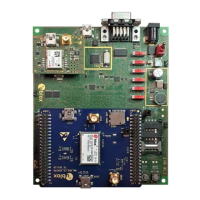SARA-R5 series - System integration manual
UBX-19041356 - R04 System description Page 32 of 118
C1-Public
The different power saving configurations that can be set by the +UPSV AT command are described
in detail in the following subsections. Table 8 summarizes the UART interface communication process
in the different power saving configurations, in relation with HW flow control settings and RTS and
DTR input lines status. For more details on the +UPSV AT command description, see the SARA-R5
series AT commands manual [2].
Communication during idle mode and wake-up
Data sent by the DTE are correctly received by the module.
Data sent by the module are correctly received by the DTE.
Data sent by the DTE are correctly received by the module.
Data sent by the module is buffered by the module and will be correctly
received by the DTE when it is ready to receive data (i.e. RTS line will be
ON).
Data sent by the DTE are correctly received by the module.
Data sent by the module are correctly received by the DTE if it is ready
to receive data, otherwise data are lost.
Data sent by the DTE should be buffered by the DTE and will be
correctly received by the module when active mode is entered.
Data sent by the module are correctly received by the DTE.
Data sent by the DTE should be buffered by the DTE and will be
correctly received by the module when active mode is entered.
Data sent by the module are buffered by the module and will be
correctly received by the DTE when it is ready to receive data (i.e. RTS
line will be ON).
The first character sent by the DTE is lost, but after ~15 ms the UART
and the module are waked up: recognition of subsequent characters is
guaranteed after the complete UART / module wake-up.
Data sent by the module are correctly received by the DTE if it is ready
to receive data, otherwise data are lost.
Not applicable: HW flow control cannot be enabled with AT+UPSV=2.
Data sent by the DTE are correctly received by the module.
Data sent by the module are correctly received by the DTE if it is ready
to receive data, otherwise data are lost.
Data sent by the DTE are lost.
Data sent by the module are correctly received by the DTE if it is ready
to receive data, otherwise data are lost.
Data sent by the DTE are correctly received by the module.
Data sent by the module are correctly received by the DTE.
Data sent by the DTE are lost.
Data sent by the module are correctly received by the DTE.
Data sent by the DTE are correctly received by the module.
Data sent by the module are buffered by the module and will be
correctly received by the DTE when it is ready to receive data (i.e. RTS
line will be ON).
Data sent by the DTE are lost.
Data sent by the module are buffered by the module and will be
correctly received by the DTE when it is ready to receive data (i.e. RTS
line will be ON).
Data sent by the DTE are correctly received by the module.
Data sent by the module are correctly received by the DTE if it is ready
to receive data, otherwise data are lost.
Data sent by the DTE are lost.
Data sent by the module are correctly received by the DTE if it is ready
to receive data, otherwise data are lost.
Table 8: UART and power-saving summary

